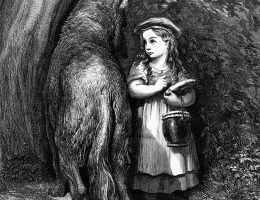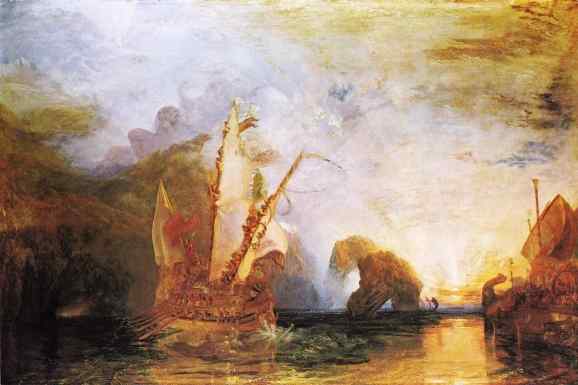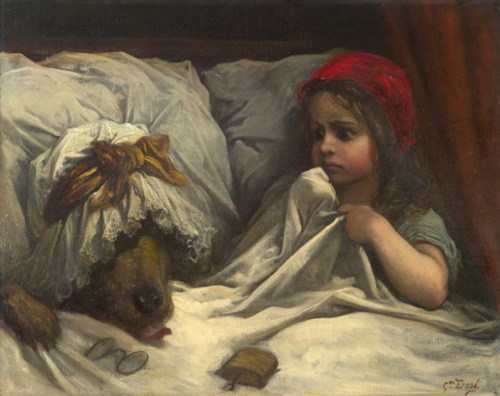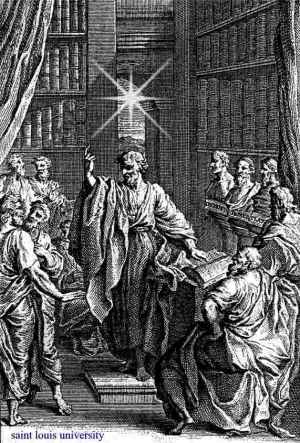Little Red Riding Hood and Longinus: The Problems of Morality and “Great” Literature
Usually, literary crticism informs how we read literature. But what happens when we turn the relationship around, and instead ask what we can learn about a work of literary criticism by using literature as a tool? As an interesting example: What can Little Red Riding Hood, a fairy tale, tell us about Longinus’ On Sublimity, one of the oldest documented works of literary criticism?

Longinus, in his treatise On Sublimity (written in either the first or third century AD), begins by defining his target term generally: “Sublimity is a kind eminence or excellence in discourse” (143). This working definition is expanded by sifting through examples of what he deems sublime literature, until it becomes clear that Longinus takes sublimity to be a rare success in arranging rhetoric to produce states of “ecstasy” in readers: namely, wonder, astonishment, and sometimes even terror (149, 143, 151). But he is not done, for he also explains that sublimity cannot come from orators with “low or ignoble thoughts,” and that “lowness of diction also destroys grandeur” (150, 184).
The implication seems to be that, in his system of value and judgment, works of humble style and diction can never be considered “great” literature. However, what would Longinus make of a work that uses humble style and diction but whose orator writes with high and noble (i.e., “great”) thoughts in mind? What can a work that would seem to be excluded from Longinus’ notion of literary excellence, such as Angela Carter’s idiomatically-humble and moralizing Little Red Riding Hood fairy tale (1979, but a translation of Charles Perrault’s 1697 Histoires ou contes du temps passe avec des moralites), teach us about Longinus’ theory of sublimity and its relationship to morality and the written word?
Ultimately, Carter’s fairy tale shows us that the analytical distance that develops when reading a cautionary moral preceded by horrifying fictional events actually ensures that wonder, astonishment, and terror can never occur for the reader. There is no room for morality in Longinus’ theory of sublimity because for a work to focus on as mortal a concern as morality detracts from great literature’s aim; after all, he asserts that “something higher than human is sought in literature” (179).

But before reaching that ultimate conclusion, we should concretely determine why Carter’s fairy tale would seem to be excluded from Longinus’ notion of literary excellence: given its moralistic/didactic nature, Carter’s fable flies in the face of Longinus’ notion of sublimity. Not only does the moral of her fairy tale fail to elicit awe, wonder, or terror, but, in order to teach a lesson, the moral also draws attention to rhetorical tricks deployed in the tale which precedes it.
In Carter’s tale, the wolf tricks the Grandmother and then throws himself “on the good woman” to “gobble her up”; this use of “gobbling up” is rather vague, and is repeated when Little Red Riding Hood is tricked by the wolf, but only after she has “[taken] off her clothes” to lie down in the bed (2-3). Then, in the moral, Carter explains that “there are real wolves, with hairy pelts and enormous teeth; but also wolves who seem perfectly charming, sweet-natured and obliging, who pursue young girls in the street and pay them the most flattering attentions” — that Carter distinguishes between “real wolves” and a different type of wolves, who are found in the “street” and have human-associative characteristics of being “charming” and “flattering,” draws attention to the fact that the author has been using a metaphor throughout the entire fable (3).

We see that the metaphor is weakened in Longinus’ eyes precisely because rhetorical tricks are generally best when they are concealed (164). Whatever brief wonder the reader may have felt after reading an unbelievable line like “The wolf opened the latch and opened the door” morphs into comprehension as soon as he/she reads the moral. What is more, if the story is known to be a fable before even being read, then the brief moment of wonder will likely never occur.
That Carter’s fairy tale uses humble style and diction is apparent from even the briefest of glances (“cake baked on the griddle,” “deep in the heart of the country,” “woodcutters working nearby,” “rat tat tat”); the combination of such “lowness of diction” with what are certainly high and noble thoughts behind the moral (“Children […] ought never to talk to strangers,” for that is a “dangerous” thing to do) sheds light on why Longinus’ theory of sublimity is unwilling to cede that great literature should shape readers’ morality for the better. In essence, Longinus appears to claim that including a moral in a work is a surefire way to prove its user to be human, effectively limiting any chance for the work to attain sublimity (178). Seemingly, the attainment of sublimity requires an escape, and if, as some argue, Carter “sympathizes with many of the persecuted or oppressed protagonists,” that sympathy is too attached to mortal concerns to allow for the release via grandeur (xxiv).
This sheds light on Longinus’ claim that “the poet is accustomed to enter into the greatness of his heroes”; a sublime work bears traces of the author’s elimination of distance between work and self (152). The analytical distance retained through the ever-present sense of moralism in Carter’s fairy tale does not mesh with Longinus’ notion of sublimity: as he explains, “Greatness of mind wanes, fades, and loses its attraction when men spend their admiration on their mortal parts and neglect to develop the immortal” (187).

Whereas Perrault was fond of the “high-flown” rhetoric that Longinus claims raises us to the “spiritual greatness of god,” Carter was more fond of “practical” folk tales (Zipes xix-xx, Longinus 178). Her aim to provide applicable moral distinctions for her readers helps us to understand why Longinus frowns upon language of the everyday: “the useful and necessary are readily available to man, it is the unusual that always excites our wonder” (178). The feeling of ecstasy arising from great literature seems to come from a place beyond familiarity, beyond universal accessibility.
What is quite interesting about Longinus’ treatise is how its desired function as a teaching tool actually creates analytical distance between the excerpts he claims are sublime and his didactic remarks — this is the same analytical distance created between the Little Red Riding Hood fairy tale and Carter’s moral. From the outset, Longinus positions his treatise as what we might call a textbook: “Let us then consider whether there is anything in my observations which may be thought useful to public men” (143). In this way he presents his work as something entirely distinct from the literature he deems sublime.
His concern with his contemporaries’ morality in the appendix (“avarice,” “insolence,” “lawlessness,” “idleness”) also attests to a great interest in their worldly, very much not “higher than human,” issues, even if the sentiment arises out of a yearning for them to stop admiring their “moral parts” and begin to “develop the immortal.” While Longinus champions the production of works “worthy of eternity,” he does so by writing a piece of literary analysis that concludes by ruing the vices of humans from a particular historical moment (150). If he hopes to shape his readers’ morality for the better, it would seem to follow that he must disavow his treatise as sublime in and of itself. The question then beckons: by Longinus’ standards, can any literary analysis possibly be sublime? Will analysis forever be considered less than the “great literature” it engages with?
What do you think? Leave a comment.











Excellent piece. This isn’t a topic I know much about, and I find myself drawn to exploring it further now. Thank you for sharing!
Great work! I wonder if you know of any other children’s stories that can do the same?
I’ve never thought about how important the analysis is when compared to the work itself. Just from a simple stand point, one may say that the literature itself is more important because that’s where any analysis starts. But when you make it as simple as that, then people will tend to dismiss any analysis and only appreciate the work, when it is probably just as important to take a look at what people have said about whatever piece it is. I think of how many people will often talk about how great the essays of Roger Ebert and Pauline Kael were; so much so, that they begin to make it sound like the analysis is better than whatever movie they’re talking about. As silly as it sounds, it kind of reminds me of that scene from Full Metal Jacket where Gunny Hartman is chanting, “This is my rifle, this is my guy, this is for fighting, this is for fun.” Perhaps in this context its, “This is my analysis, this is my book, this is for writing, this is for fun.” Doesn’t quite have the same ring to it, but that’s the way I figure it ought to be. Great article by the way 🙂
Excellent piece! You elaborate a very convincing and precise analysis of difficult literary theories, all based on a well-know tale, and you succeed in showing a new side to it, which is brilliant. Thank you for this!
This story is impossible. A wolf can’t swallow a person whole and then cutting a wolf’s belly to get the riding hood and grandmother out
This book is great for teaching traditional fairy tales.
Outstanding read!
Thank you for the stimulating article. I enjoyed reading your work it made me have to really stop and think. I did enjoy your selection of Little Red Riding Hood and I didn’t really equate the morale side about being aware of people in surroundings as a cautionary tale to head warning. To answer the question, “Can fairy tales be considered “great” literature? And who’s deciding?” The answer to the first question is defiantly yes, fairy tales are great literature in its most simplistic form. This simplicity allows for a wider audience a greater appeal. However this does not mean that because something is simple and a great amount of people know of it makes it good, that is just a good PR person. The test of time is a great measuring tool as well. Again with simplistic tools such as an oral storytelling and pictorial tools a story can transcend many classes and subgroups of people. It is not limited to the affluent and academically educated. The simplistic nature also allows for translation into other languages and other cultures can absorb the great tales. For example the stories of the Sumerian Gilgamesh can be found in many other cultures and this was through oral stories ,pictures and cuneiforms. Even Aesop’s fables are simple and filled with moral issues with opportunities for growth. These simple tales are still told and are the foundation for other works of literature. When another artist, writer, film maker or musician bases their work on fairy tales of the past and brings it forward to the current generation such as the film Hansel and Gretel: Witch Hunters (2013) the test of time is measured and each new generation is deciding if the tales will continue. Also nice visuals.
Thanks for this. Your title made me come in…!
Interesting…Having a moral makes can discourage analysis not only because it suggests intention but because it limits the revelation…This reminds me of Aesop’s tales and how modern versions include a little moral at the end but none existed before. I suppose that means it is sublime to those who have never heard them before, or can write their own morals/find their own meaning and analysis. As for writing analysis, that is an expression of wonder and the sublime, but should not replace another’s experience of the work. Always read criticism after reading the actual work.
This is a very well written and analysis, provoking thoughts concerning the status of morals in all literature. Fairy tales and fables are the basis of many of literary pieces which can be considered ‘great’; much of literature can be intrinsically moralistic as this is the basis of basic human life and analysis, and literature is written by a human author, rather than following anything ‘sublime’. One of fictions purposes is to demonstrate and analyse the world around us, perhaps through depictions of that which may be ‘awe inspiring’. Your article highlighted the functions of analysis and criticism in understand this function within literature.
Short, succinct, highly interesting piece. I loved the pictures you used!
Very interesting piece. I would say that literary analysis can never approach the sublimity of literature (or art in general, for that matter)- simply for the reason that it is too explicit, or looking to explicate something that is implicit, if that makes any sense . . . Although if you consider metafiction, the question is not that easy, since you are talking about a work that refers back to itself/is a part of its own analysis.
Anyhow, really liked your article because I learned so much I didn’t know! It also made me think of something Emily Dickinson once said: “I know nothing in the world that has as much power as a word. Sometimes I write one, and I look at it, until it begins to shine.”
I would say that literary analysis can definitly approach the sublimity of literature! If you look at Tolkein’s “Beowulf: The Monster and the Critics” or “A Gloss on Heavy Metal’s Orinary Song” which is an essay on the lyrics of ‘Black Sabbath’ by Black Sabbath, (please do look at them both, they are well worth a read!) you get in-depth analyis that brings up as many questions as it answers and leaves the reader in awe of the analyser and the work they are analysing – surely that is sublime?
Great idea for piece, and excellent choice of example in terms of the Angela Carter story. I haven’t read Longinus’ ‘On Sublimity’ but feel compelled to do so now!
Very insightful, and also very relevant to the popular perception of fiction today. I find it disheartening to read comment after comment criticizing some work of fiction for ‘sending the wrong message’, as if the inherent role of storytelling were always to serve as a moral compass, or propaganda for some ‘socially acceptable’ ideas.
Nice to hear about literary criticism from almost 2000 years ago.